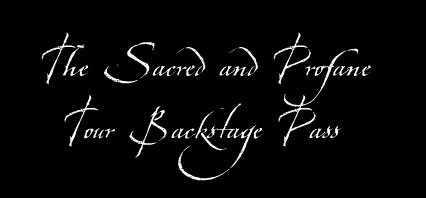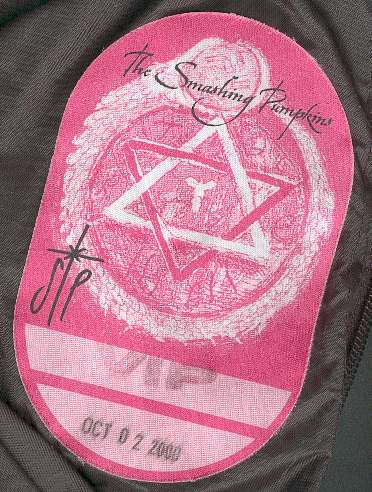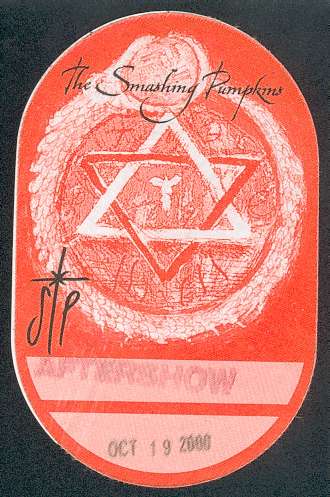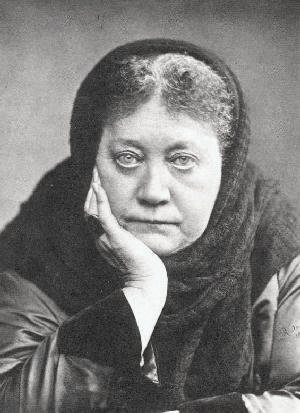
All content & writing by Brad Jaeger © The NACHTKABARETT
 |
 |
| Original Source of Image: Used as a backstage pass and to grant access to after shows. | |
The symbol was initially created as means of identifying the Theosophical Society, an esoteric group founded in the early 19th century.
The term 'Theosophia' derives from the Greek combination of 'Theos' (God) & 'Sophos' (Wise). Along with several others, Helena Blavatsky founded the group in 1875. Blavatsky was already a prominent member of the Order of the Eastern Star, an association affiliated with the greater branch of Freemasonry, having worn the Eastern Star Emblem most of her life.
 Madame Blavatsky
Madame Blavatsky |
 |
Left: Blavatsky's seal, used as her personal insignia for many years, and from which the public seal was developed. Right: The Theosophical Society's public logo, likely the primary source of The Smashing Pumpkin's image upon their backstage passes. This symbol is devoid of the crown, the Kabbalistic and astrological symbols, and Blavatsky's personal monogram originally placed in the center of the Hexagram. In place of the monogram is the ankh, also known as the ansated cross or the looped tau cross. Five primary symbols are featured in the majority of the Theosophical Society's imagery: The Star of David, The Ouroboros, the Swastika, the Ankh, and Aum. |
|
It is worthwhile to note that these symbols specifically relate to a number of the society's teachings. Some of these teachings pertain to the infinite, yet regenerative and cyclical nature of the universe. Other concepts pertain to the cosmic relation of microcosm and macrocosm (as displayed by the hexagram, composed of two triangles: one black, one white, reflecting the hermetic maxim, "as above, so below"), and the illumination of the eternal and wise as the heart of the universe.
 Another example of the logo. The sacred symbol of Aum can be seen resting atop the encircled swastika. The personal motto of the Theosophical Society bends around the Ouroboros, "There is no religion higher than truth".
Another example of the logo. The sacred symbol of Aum can be seen resting atop the encircled swastika. The personal motto of the Theosophical Society bends around the Ouroboros, "There is no religion higher than truth".Other symbols which have been used include: the white dove, the astrological symbols of Leo and Virgo, and the five pointed crown.
It appears as though the white dove is the symbol present within The Smashing Pumpkin's depiction of the seal -- in place of the ankh -- spreading its wings into the shape of the Tau, though I cannot affirm this in full confidence without higher resolution photos.
A description of the public image of the seal, as provided by the Theosophical Society's website states:
In its original and its present form, the Society design contains a synthesis of the basic teachings of theosophy. It represents the universe expanding into manifestation, or evolution, from the central heart, and comprised within the serpent of time and space. The white triangle represents wisdom concealed and the black one wisdom revealed, as well as other things. The tau not only stands for the regenerated man but for life, and the circle hovering over the cosmic cross is the golden germ which will expand into future glory as the neophyte or 'embryo' develops into the grown-up being. The swastika in the small circle may be taken for the great mill of the gods, the cycle of transformation, the "Wheel of the Law." The broken ends of the swastika may turn either way without changing the symbolism.
I quote Alexander Roob, who provides further information pertaining to the founding of the society:
Alexander Roob's, Alchemy and Mysticism: The Hermetic MuseumIn the emblem of the Theosophical Society, a combination of the western Ouroboros, the eastern Swastika, the Jewish star of David and the ancient Egyptian Ankh, its syncretic programme is very directly expressed.
The society was founded in New York in 1875 by the Russian emigrant Helena P. Blavatsky (1831-1891), described by W.B Yeats as a "primeval peasant". In Joyce's Finnegan's Wake, she appears as a hen scratching a mysterious piece of writing from a dung-heap. This is her 'Secret Doctrine', published in three volumes in 1888, a mythical pot-pourri such as is found, for example, in paintings by Max Beckmann, imbued with the spirit of fin-de-siècle salon spiritualism.
In 1879 the society moved its main seat to Adyar in India. The mixture of Eastern spirituality and Western occultism made a decisive contribution to the development of abstract painting. Wassily Kandin and Piet Mondrian were among the society's devotees.
Her programme of "science, religion, and philosophy", which she sought to promulgate with a keen sense of dramatic effect, also makes Madame Blavatsky a herald of the New Age movement of the late 20th century.
According to her theory, the whole cosmos consists of a seven-stage process of evolution and involution. The goal of humanity is the upward development from the sexual, material body to the ethereal, light body. This path leads from the currently dominant Aryan mother-race to a sublimated race of people that she saw emerging in the America of her own time. It is clear that such doctrines, which were easily compatible with the inhuman racial doctrines of Guido von List and Lanz-Liebenfels, could become esoteric supports for the formation of the Nazi ideology."
